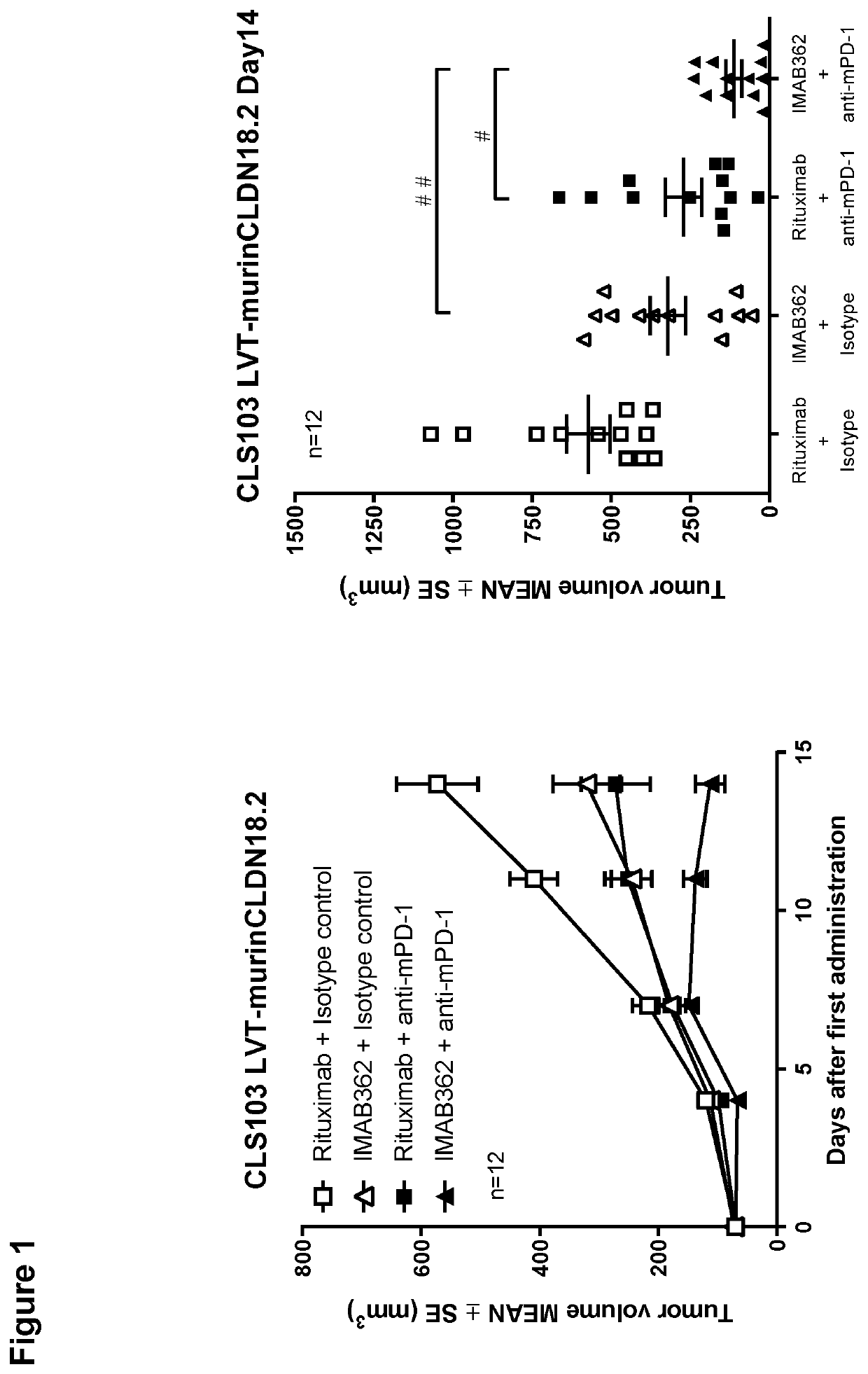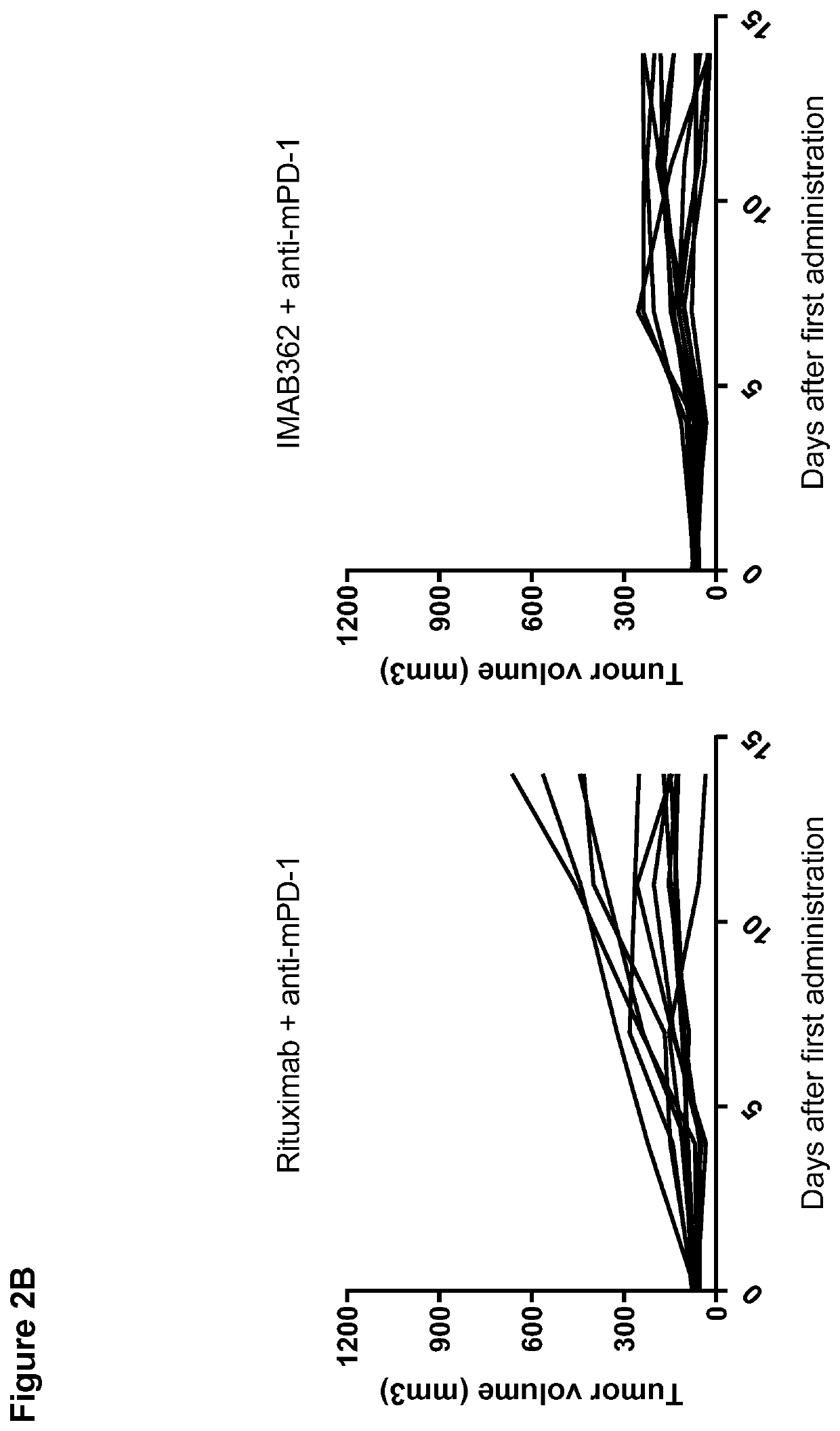Combination therapy involving antibodies against claudin 18.2 and immune checkpoint inhibitors for treatment of cancer
a technology of immune checkpoint inhibitors and cancer, which is applied in the direction of antibody medical ingredients, drug compositions, peptides, etc., can solve the problems of negative signaling that decreases the efficacy of igg1 monoclonal antibodies (mabs) triggering adcc, the medical need is still high, and the mabs face several limitations
- Summary
- Abstract
- Description
- Claims
- Application Information
AI Technical Summary
Benefits of technology
Problems solved by technology
Method used
Image
Examples
example 1
Studies of the Combination of Anti-CLDN18.2 Antibodies and Immune Checkpoint Inhibitors In Vivo
[0379]In order to determine whether a combination of an anti-CLDN18.2 antibody and an immune checkpoint inhibitor provides improved anti-tumor activity over the single agents alone in vivo, anti-tumor activity of IMAB362 in combination with an anti-mPD-1 antibody was examined in a subcutaneously transplanted syngeneic gastric carcinoma model in immunocompetent outbred Crl:NMRI(Han) mice using CLS-103 cells with lentiviral transduction of murine CLDN18.2 (CLS-103 LUT-murinCLDN18.2). Rituximab was used as an isotype control of IMAB362.
Test Antibodies
[0380]Anti-CLDN18.2 antibody: IMAB362 (Astellas Pharma Inc.)[0381]control antibody: Rituximab BS Intravenous Infusion [KHK] 500 mg (Kyowa Hakko Kirin Co., Ltd., Cat #22900AMX00971000)[0382]Anti-mPD-1 antibody: InVivoMAb anti-mouse PD-1, clone RMP1-14 (BioXCell, Cat #BE0146)[0383]isotype control antibody: InVivoMAb rat IgG2a isotype control, anti-...
example 2
Efficacy Studies of the Combination of Anti-CLDN18.2 Antibodies and Immune Checkpoint Inhibitors In Vivo
[0386]In order to determine whether a combination of an anti-CLDN18.2 antibody and an immune checkpoint inhibitor improves anti-tumor activity over the single agents alone in vivo in long-term period, anti-tumor activity of IMAB362 in combination with an anti-mPD-1 antibody was examined up to day 28 in a subcutaneously transplanted syngeneic gastric carcinoma model in immunocompetent outbred Crl:NMRI(Han) mice using CLS-103 cells with lentiviral transduction of murine CLDN18.2 (CLS-103 LVT-murinCLDN18.2). Rituximab was used as an isotype control of IMAB362.
Test Antibodies
[0387]Anti-CLDN18.2 antibody: IMAB362 (Astellas Pharma Inc.)[0388]control antibody: Rituximab BS Intravenous Infusion [KHK] 500 mg (Kyowa Kirin Co., Ltd., Cat #22900AMX00971000)[0389]Anti-mPD-1 antibody: InVivoMAb anti-mouse PD-1, clone RMP1-14 (BioXCell, Cat #BE0146)[0390]isotype control antibody: InVivoMAb rat I...
example 3
Studies of the Combination of Anti-CLDN18.2 Antibodies and Immune Checkpoint Inhibitors In Vivo
[0393]In order to determine whether a combination of an anti-CLDN18.2 antibody and an immune checkpoint inhibitor improves anti-tumor activity over the single agents alone in vivo, anti-tumor activity of IMAB362 in combination with an anti-mCTLA-4 antibody was examined in a subcutaneously transplanted syngeneic gastric carcinoma model in immunocompetent outbred Crl:NMRI(Han) mice using CLS-103 cells with lentiviral transduction of murine CLDN18.2 (CLS-103 LVT-murinCLDN18.2). Rituximab was used as an isotype control of IMAB362.
Test Antibodies
[0394]Anti-CLDN18.2 antibody: IMAB362 (Astellas Pharma Inc.)[0395]control antibody: Rituximab BS Intravenous Infusion [KHK] 500 mg (Kyowa Kirin Co., Ltd., Cat #22900AMX00971000)[0396]Anti-mCTLA-4 antibody: InVivoMAb anti-mouse CTLA-4, clone 9D9 (BioXCell, Cat #BE0164)[0397]isotype control antibody: InVivoMAb mouse IgG2b isotype control, unknown specific...
PUM
| Property | Measurement | Unit |
|---|---|---|
| molecular weight | aaaaa | aaaaa |
| molecular weight | aaaaa | aaaaa |
| dissociation constant | aaaaa | aaaaa |
Abstract
Description
Claims
Application Information
 Login to View More
Login to View More - R&D
- Intellectual Property
- Life Sciences
- Materials
- Tech Scout
- Unparalleled Data Quality
- Higher Quality Content
- 60% Fewer Hallucinations
Browse by: Latest US Patents, China's latest patents, Technical Efficacy Thesaurus, Application Domain, Technology Topic, Popular Technical Reports.
© 2025 PatSnap. All rights reserved.Legal|Privacy policy|Modern Slavery Act Transparency Statement|Sitemap|About US| Contact US: help@patsnap.com



